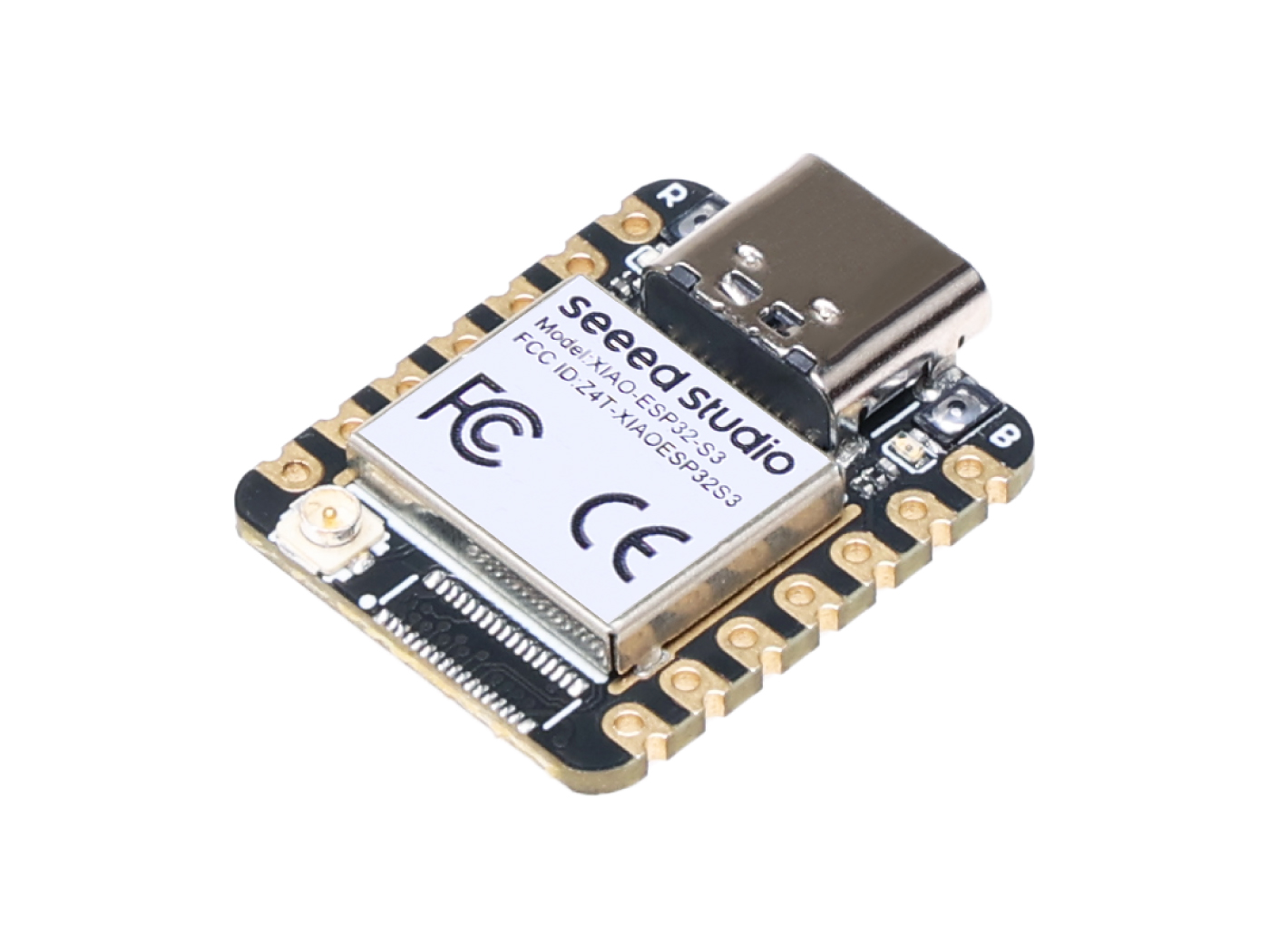Seeed Studio XIAO ESP32S3
chip:esp32, chip:esp32s3
The Seeed Studio XIAO ESP32S3 is a general purpose board supplied by Seeed Studio and it is compatible with the Espressif ESP32S3 ecosystem, sharing the same MCU as ESP32-S3-DevKitC.

Features
- ESP32-S3R8 Xtensa LX7 dual-core, 32-bit processor that operates at up to 240 MHz
- On-chip 8M PSRAM & 8MB Flash
- USB Type-C interface
- Wireless: Complete 2.4GHz Wi-Fi subsystem;
- BLE: Bluetooth 5.0, Bluetooth mesh
- 1x UART, 1x I2C, 1x I2S, 1x SPI, 11x GPIOs (PWM), 9x ADC
- 1 user LED, 1 power LED
- 1 RESET button, 1 BOOT button
NSH Console
The NuttShell (NSH) console is available over USB using the CDC/ACM serial interface. To access the console, connect via a terminal emulator at 115200 baud, 8 data bits, no parity, and 1 stop bit (115200-8N1).
User LED
The USER LED, a yellow LED located on the XIAO ESP32S3 board, is connected to GPIO21 as indicated in the board's schematic. This LED can be controlled through NuttX by configuring GPIO21 as an output and toggling its state.
Buttons
The RESET and BOOT buttons can be used to enter "Bootloader" mode by press and hold the BOOT key while powering up and then press the RESET key once.
Pin Mapping
Pads numbered anticlockwise from USB connector.
Pad Signal Notes
0 GPIO01 D0/A0 1 GPIO02 D1/A1 2 GPIO03 D2/A2 3 GPIO04 D3/A3 4 GPIO05 D4/SDA 5 GPIO06 D5/SCL 6 GPIO43 D6/Default TX for UART0 serial console 7 GPIO44 D7/Default RX for UART0 serial console 8 GPIO07 D8/SCK 9 GPIO08 D9/MISO 10 GPIO09 D10/MOSI 11 12 3V3 Ground Power output to peripherals 13 VIN +5V Supply to board
Power Supply
The working voltage of the MCU is 3.3V. Voltage input connected to general I/O pins may cause chip damage if it's higher than 3.3V.
Installation
- Configure and build NuttX:
git clone https://github.com/apache/nuttx.git nuttx
git clone https://github.com/apache/nuttx-apps.git apps
cd nuttx
make distclean
./tools/configure.sh xiao-esp32s3:usbnsh
make V=12. Connect the Seeed Studio XIAO ESP32S3, and enter "Bootloader" mode, then, flash the nuttx.hex file using esptool: (https://docs.espressif.com/projects/esptool/en/latest/esp32/)
Example command:
make flash ESPTOOL_PORT=/dev/ttyACM0 ESPTOOL_BINDIR=./Configurations
usbnsh
Basic NuttShell configuration using CDC/ACM serial (console enabled in USB Port, at 115200 bps).
NuttShell (NSH) NuttX-12.8.0
nsh> uname -a
NuttX 12.8.0 2c845426da-dirty Apr 6 2025 22:53:57 xtensa esp32s3-xiaocombo
This configuration enabled NuttShell via USB and enabled led and gpio examples:
Testing leds:
nsh> leds
leds_main: Starting the led_daemon
leds_main: led_daemon started
led_daemon (pid# 10): Running
led_daemon: Opening /dev/userleds
led_daemon: Supported LEDs 0x01
led_daemon: LED set 0x01
nsh> led_daemon: LED set 0x00
led_daemon: LED set 0x01
led_daemon: LED set 0x00
led_daemon: LED set 0x01
led_daemon: LED set 0x00Testing gpios:
PIN/GPIO Mode Device
D1/GPIO2 Output /dev/gpio0 D0/GPIO1 Input /dev/gpio1 D2/GPIO3 Input /dev/gpio2
nsh> ls /dev
/dev:
console
gpio0
gpio1
gpio2
null
ttyACM0
ttyS0
userleds
zero
nsh> gpio -o 1 /dev/gpio0
Driver: /dev/gpio0
Output pin: Value=0
Writing: Value=1
Verify: Value=1
nsh> gpio -o 0 /dev/gpio0
Driver: /dev/gpio0
Output pin: Value=1
Writing: Value=0
Verify: Value=0
nsh> gpio /dev/gpio1
Driver: /dev/gpio1
Input pin: Value=0
nsh> gpio /dev/gpio1
Driver: /dev/gpio1
Input pin: Value=1
nsh> gpio /dev/gpio1
Driver: /dev/gpio1
Input pin: Value=0
nsh> gpio -w 1 /dev/gpio2
Driver: /dev/gpio2
Interrupt pin: Value=0
Verify: Value=1
nsh> gpio -w 1 /dev/gpio2
Driver: /dev/gpio2
Interrupt pin: Value=0
Verify: Value=1